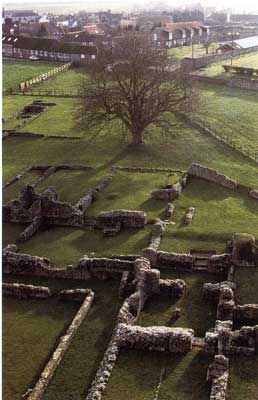The Monastic Precinct
Additional notes by Dr Peter Wade-Martins, Norfolk Archaeological Trust
 To the side of the present church are the remains of thepriorycloisters and the buildings which surrounded them. At the far end of the church are the central tower and transepts and the original east end. All these were pulled down after the priory was closed in 1539.This area was purchased by the Norfolk Archaeological Trust in 1933, and the excavated remains are now in the care of English Heritage. The only intact part of the priory is the nave, which was the area of worship set aside for local people in the Middle Ages. There was never a separate parish church.
To the side of the present church are the remains of thepriorycloisters and the buildings which surrounded them. At the far end of the church are the central tower and transepts and the original east end. All these were pulled down after the priory was closed in 1539.This area was purchased by the Norfolk Archaeological Trust in 1933, and the excavated remains are now in the care of English Heritage. The only intact part of the priory is the nave, which was the area of worship set aside for local people in the Middle Ages. There was never a separate parish church.
Visitors to the church come through the fragments of the priory gatehouse by the road. This has also recently been purchased by the Archaeological Trust and is due for restoration. The gatehouse was the main entrance into the priory precinct, now mostly occupied by the large meadow which surrounds the church. The oval of streets around this meadow still define the precinct boundary, and parts of the medieval wall can be seen alongside the road near the gatehouse. Earthworks of monastic buildings not yet excavated are also visible in the meadow.
When the priory was closed in 1539 the building materials were sold and dispersed. There must be as many stones from the priory now built into houses in the village as there are still on site! Walking around Binham looking for priory stonework is, in itself, a fascinating exercise.
When the South aisle came down, the arcade arches were blocked, and after demolition only a few stumps of stonework were left sticking out of the ground.
The excavations
 After the area was purchased by the Archaeological Trust in 1933, it was immediately transferred into the official Guardianship of the old Office of Works which was able to fund the clearance and consolidation of the exposed walls.
After the area was purchased by the Archaeological Trust in 1933, it was immediately transferred into the official Guardianship of the old Office of Works which was able to fund the clearance and consolidation of the exposed walls.
Excavation took place every summer from 1934 until 1938, and work finished just before war broke out in 1939. Excavation in those days was more a question of rubble clearance using unsupervised workmen than the careful and delicate work we would expect today. Whatever records may have been made at the time did not survive the war or the sudden death in 1939 of the excavator, Henry Neville, who having retired from the Indian Civil Service, had been the driving force behind the whole project.The only part of the excavation archive we have now are the boxes of medieval pottery, bones and tiles in the stores of the Norfolk Museums and Archaeology Service. They still need to be examined.
A team of stonemasons was also employed repairing and consolidating the exposed stonework. There is a record of how much was actually spent each year over the five years on the excavations and on the repairs, because it was all approved in memos held in an old Office ofWorks file now kept in the Public Records Office.
Priory remains
The central feature of the monastery was the square cloister walk with its lean-to roof. This gave sheltered access from the monastery into the south aisle of the church in two places and also between the buildings around the other sides of the central square.
The buildings on the east side of the cloisters included the chapter house (where monks held their business meetings), the monks' parlour (or sitting room), the warming room (with fireplace to provide warmth on chill winter evenings) and an upstairs dormitory with a vaulted undercroft below. Leading off the dormitory is the reredorter (toilets), not yet excavated.
On the south side of the cloisters is the large refectory (dining room), served by kitchens behind. To the west there would have been storerooms and accommodation for the prior and his guests, although how this was all arranged is not entirely clear.
The further away from the cloisters you go the less easy it is to interpret the excavated structures. There was a malting kiln in a building at the south end of the east range, which was used until the eighteenth century. Traces of other unexcavated structures disappear out into the surrounding meadow beyond the area purchased in 1933.
For further information about this site and of others owned by the Norfolk Archaeological Trust, do visit our website at http:// www.norfarchtrust.org.uk